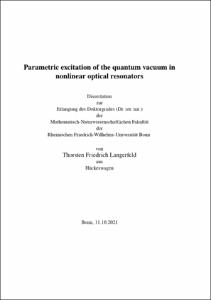Parametric excitation of the quantum vacuum in nonlinear optical resonators

Parametric excitation of the quantum vacuum in nonlinear optical resonators

| dc.contributor.advisor | Köhl, Michael | |
| dc.contributor.author | Langerfeld, Thorsten Friedrich | |
| dc.date.accessioned | 2022-07-25T11:43:39Z | |
| dc.date.available | 2022-07-25T11:43:39Z | |
| dc.date.issued | 25.07.2022 | |
| dc.identifier.uri | https://hdl.handle.net/20.500.11811/10107 | |
| dc.description.abstract | In this thesis, I present the generation of correlated photon pairs in high-finesse nonlinear optical micro-resonators. In a first attempt, we utilize the third-order nonlinear material polarization of the dielectric mirror coatings to generate correlated photon pairs via spontaneous four-wave mixing. Two pump photons are annihilated and a pair of signal and idler photons is created, a process where the cavity pump mode couples to adjacent cavity modes. We observe the photon pairs in the first spectral order, i.e. the frequencies are shifted by one free spectral range up- and downwards with respect to the pump mode, driven on the experimentally determined dispersion-compensated cavity resonance. We measure a photon-pair production rate of Γexp = 0.22(1) s-1W-2 with respect to the intra-cavity power. The experiment demonstrates the fast response of the dielectric polarization to the rapidly oscillating standing wave inside the cavity and determines the magnitude of the nonlinearity of the dielectric coating stack.
Even though the size of the nonlinear material is restricted to sub-wavelength scales, i.e. the penetration depth of the electromagnetic wave into the dielectric mirror coating, a measurable amount of photon pairs is generated. In order to increase the stream of photon pairs, we filled a resonator with silicone oil to extend the interaction region to the whole cavity length. We observe a photon-pair production rate of Γexp = (330 ± 30) s-1W-2, which is an increase of more than three orders of magnitude as compared to the empty cavity. The spectral brightness is (44 ± 8) mW-2s-1MHz-1, showing the narrow-band properties of the photon-pair source. Furthermore, we demonstrate the possible tunability of the photon frequencies by changing the spectral separation of the signal and idler mode to the pump mode. This is achieved by using pairs of longitudinal cavity modes shifted by multiples of the free spectral range. These experiments show a formal equivalence to the dynamical Casimir effect where a time-dependent boundary condition to the electromagnetic field, e.g. an oscillating cavity length, gives rise to the excitation of photon pairs out of the vacuum. Both experiments can thereby be interpreted as the periodic modulation of the refractive index and, hence, the effective cavity length. By changing the pump geometry, we modulate the refractive index in the dielectric mirror coating of a micro-cavity with two dissimilar high-intensity lasers incident from the side of the resonator. The refractive index is then modified at the difference frequency of both lasers, adjusted to be twice the cavity resonance frequency. The modulation couples to the unoccupied cavity mode and gives rise to the creation of correlated photon pairs out of the vacuum state via parametric excitation. The underlying process is distinctive to the former spontaneous four-wave mixing, since one higher frequency pump photon is annihilated and a lower frequency pump photon is generated with the excess creating the photon pair on the unoccupied cavity mode. We measure a correlation signal outstanding almost four standard deviations from the mean accidental coincidence background. We exclude thermal radiation as origin for the observation by reference measurements and estimate the probability of a random appearence of the signal to be less than 0.01 %. | en |
| dc.language.iso | eng | |
| dc.rights | In Copyright | |
| dc.rights.uri | http://rightsstatements.org/vocab/InC/1.0/ | |
| dc.subject | Photonenpaare | |
| dc.subject | korrelierte Photonen | |
| dc.subject | Quantenphysik | |
| dc.subject | Quantenelektrodynamik | |
| dc.subject | Quantenoptik | |
| dc.subject | Vakuumfluktuationen | |
| dc.subject | spontane vier-Wellen-Mischung | |
| dc.subject | dynamischer Casimir Effekt | |
| dc.subject | Mikroresonator | |
| dc.subject | optischer Faserresonator | |
| dc.subject | photon pairs | |
| dc.subject | correlated photons | |
| dc.subject | quantum physics | |
| dc.subject | quantum electrodynamics | |
| dc.subject | quantum optics | |
| dc.subject | vacuum fluctuations | |
| dc.subject | spontaneous four-wave mixing | |
| dc.subject | dynamical Casimir effect | |
| dc.subject | microresonator | |
| dc.subject | microcavity | |
| dc.subject | optical fiber resonator | |
| dc.subject.ddc | 530 Physik | |
| dc.title | Parametric excitation of the quantum vacuum in nonlinear optical resonators | |
| dc.type | Dissertation oder Habilitation | |
| dc.publisher.name | Universitäts- und Landesbibliothek Bonn | |
| dc.publisher.location | Bonn | |
| dc.rights.accessRights | openAccess | |
| dc.identifier.urn | https://nbn-resolving.org/urn:nbn:de:hbz:5-66915 | |
| dc.relation.doi | https://doi.org/10.1103/PhysRevA.97.023822 | |
| dc.relation.doi | https://doi.org/10.1088/1367-2630/ab5daa | |
| ulbbn.pubtype | Erstveröffentlichung | |
| ulbbnediss.affiliation.name | Rheinische Friedrich-Wilhelms-Universität Bonn | |
| ulbbnediss.affiliation.location | Bonn | |
| ulbbnediss.thesis.level | Dissertation | |
| ulbbnediss.dissID | 6691 | |
| ulbbnediss.date.accepted | 22.02.2022 | |
| ulbbnediss.institute | Mathematisch-Naturwissenschaftliche Fakultät : Fachgruppe Physik/Astronomie / Physikalisches Institut (PI) | |
| ulbbnediss.fakultaet | Mathematisch-Naturwissenschaftliche Fakultät | |
| dc.contributor.coReferee | Hofferberth, Sebastian | |
| ulbbnediss.contributor.orcid | https://orcid.org/0000-0002-6329-7548 | |
| ulbbnediss.contributor.gnd | 1269235516 |
Dateien zu dieser Ressource
Das Dokument erscheint in:
-
E-Dissertationen (4378)




